Techno-Economic and Environmental Analysis of a Hybrid PV-WT-PSH/BB Standalone System Supplying Various Loads
Abstract
:1. Introduction
1.1. Related Works
1.2. Paper Contribution
2. Hybrid System Modeling and Simulation
2.1. PV System Model
2.2. Wind Turbine Model
2.3. Storage Systems
3. Sizing Objectives and Optimization
3.1. Objectives
3.2. Multi Objective Grey-Wolf Optimizer MOGWO
3.3. CO2 Emissions
4. Results
- Data acquisition and processing (screening for inconsistencies, such as out-of-scale values).
- Searching for an optimal system configuration (both PV–WT–PSH and PV–WT–BB) based on the methods and models presented in Section 3. Selecting system parameters that represent the optimal solution based on the Pareto front as well as those that enable the system to obtain a reliability of 95% (arbitrarily selected).
- Performing a sensitivity analysis with regard to the system reliability based on the historical time series of wind speed and irradiation covering the last 10 years.
- Estimating the system’s environmental impact in terms of CO2 emissions per unit of covered energy demand.
4.1. Case Study 1: Farm Load
4.2. Case Study 2: Hospital
4.3. Case Study 3: University
4.4. Case Study 4: Hotel Load
4.5. Case Study 5: Industrial Load—Brickyard
4.6. Case Study 6: Industrial—Grain Mill
4.7. Case Study 7: Industrial Load—Water Pumping Station
4.8. Case Study 8: Industrial—Food Factory
5. Discussion
5.1. Aggregated Load
5.2. Economic Performance
5.3. Environmental Impact
5.4. Reliability Analysis
5.5. Load Variability—Energy Cost
5.6. Study Limitations and Future Research Directions
- Considering that for all case studies relatively acceptable energy prices have been observed for a reliability of 95% it is worth investigating the potential extent of the demand-side management/load shifting that would result in increased system reliability. If the load shifting could exceed 5% of the demand it might be possible to even further reduce the energy cost or, in other words, avoid oversizing the system. Also, to increase the match between supply and demand it would be interesting to investigate the different orientations of PV systems [46].
- Systems operating in off-grid mode have to ensure the required reliability, but also provide energy at an acceptable cost. The curtailment of renewables generation leads to an increased energy cost but might be unavoidable due to the storage capacity constraints. Therefore, a tradeoff has to be made between cost and reliability. Our research shows that covering aggregated loads based on the renewable energy sources hybrid systems is more effective. However, future research should consider the use of potentially curtailed energy for the production of, for example, synthetic fuels or hydrogen, as in [47].
- The performed analysis clearly indicates that, due to the technical limitations of battery and PSH storage systems, it is necessary to in the future consider the potential option of the joint operation of those two storage technologies. Such hybridization would result in a more efficient operation of the whole system through the synergetic effect of complementary technologies [48].
- In this research, hybrid systems were operating in an off-grid mode, despite being relatively close to the national grid. In future research, it would be necessary to investigate how such a hybrid system could cooperate with the national power system by, for example, offering peak load shaving services and simultaneously minimizing the electricity cost [49].
6. Conclusions
Author Contributions
Funding
Acknowledgments
Conflicts of Interest
Nomenclature
| Maintenance and operation cost of component (€) | |
| Replacement cost of component (€/KW) | |
| Salvage value (€) | |
| Stat of charge of Battery (kWh) | |
| Energy generated from PSH station | |
| Energy pumped to upper reservoir | |
| Net present cost of component (€) | |
| Number of replacements of component | |
| Installed capacity of component (KW) | |
| Load demand (kWh) | |
| Energy produced by renewable sources (kWh) | |
| BB | Battery Bank |
| CLFT | Component lifetime (year) |
| COE | Cost of energy (€/kWh) |
| Edump | Curtailed energy |
| Eloss | Uncovered energy |
| evap | Evaporation (m3) |
| h | Head (m) |
| i | Real discount rate |
| IC | Initial cost (€) |
| LPSP | Loss of supply probability |
| MC | Maintenance and operation cost (€) |
| MOGWO | Multi-objective grey-wolf optimizer |
| ηBat | Battery efficiency |
| ηpsh | Water turbine efficiency |
| Pdif | Deficit power |
| PLFT | Project lifespan (years) |
| PSH | Pump storage hydroelectricity |
| Pss | Surplus enegy |
| PV | Photovoltaic energy |
| Qpsh | Water turbine throughput (m3/s) |
| rainfall | Precipitation (m3) |
| RC | Replacement cost (€) |
| RES | Renewable energy system |
| TAC | Total annualized cost (€) |
| V | Volume of water (m3) |
| WT | Wind energy |
| Water density (Kg/m3) |
Appendix A
Appendix A.1. PSH Operation
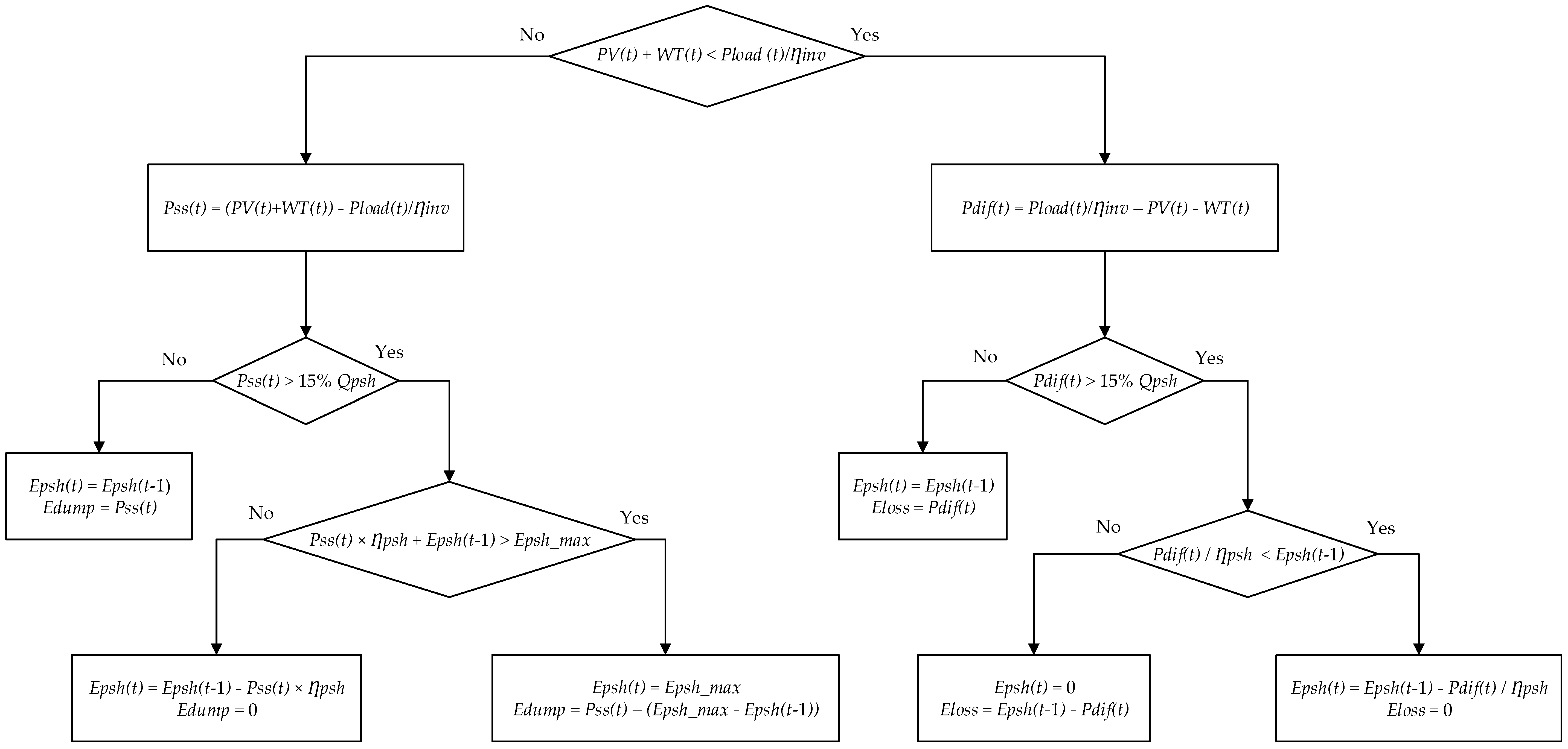
Appendix A.2. Battery Bank Modeling

Appendix B. Net Present Cost Calculation
References
- Stambouli, A.B.; Khiat, Z.; Flazi, S.; Kitamura, Y. A review on the renewable energy development in Algeria: Current perspective, energy scenario and sustainability issues. Renew. Sustain. Energy Rev. 2012, 16, 4445–4460. [Google Scholar] [CrossRef]
- Engeland, K.; Borga, M.; Creutin, J.D.; François, B.; Ramos, M.H.; Vidal, J.P. Space-time variability of climate variables and intermittent renewable electricity production—A review. Renew. Sustain. Energy Rev. 2017, 79, 600–617. [Google Scholar] [CrossRef]
- Sonelgaz. Available online: http://www.sonelgaz.dz/ (accessed on 20 September 2018).
- Portail Algérien des énergies renouvelables. Available online: https://portail.cder.dz/ (accessed on 20 September 2018).
- Stark, M.; Trinkl, C.; Zörner, W.; Greenough, R. Methodological Evaluation of Storage Systems for Flexible Power Generation from Solid Biomass. Chem. Eng. Technol. 2018, 41, 2168–2176. [Google Scholar] [CrossRef]
- Al-falahi, M.D.A.; Jayasinghe, S.D.G.; Enshaei, H. A review on recent size optimization methodologies for standalone solar and wind hybrid renewable energy system. Energy Convers. Manag. 2017, 143, 252–274. [Google Scholar] [CrossRef]
- Kaabeche, A.; Diaf, S.; Ibtiouen, R. Firefly-inspired algorithm for optimal sizing of renewable hybrid system considering reliability criteria. Sol. Energy 2017, 155, 727–738. [Google Scholar] [CrossRef]
- Greenough, R.; Jesús, P.; Fuentes, S. Energy Saving Opportunities in a Food Factory. KES Trans. Sustain. Des. Manuf. II 2015, 426–437. [Google Scholar]
- Nema, P.; Nema, R.K.; Rangnekar, S. A current and future state of art development of hybrid energy system using wind and PV-solar: A review. Renew. Sustain. Energy Rev. 2009, 13, 2096–2103. [Google Scholar] [CrossRef]
- Akikur, R.K.; Saidur, R.; Ping, H.W.; Ullah, K.R. Comparative study of stand-alone and hybrid solar energy systems suitable for off-grid rural electrification: A review. Renew. Sustain. Energy Rev. 2013, 27, 738–752. [Google Scholar] [CrossRef]
- Jurasz, J.; Mikulik, J.; Krzywda, M. Integrating a wind- and solar-powered hybrid to the power system by coupling it with a hydroelectric power station with pumping installation. Energy 2018, 144, 549–563. [Google Scholar] [CrossRef]
- Solomon, A.A.; Kammen, D.M.; Callaway, D. Investigating the impact of wind-solar complementarities on energy storage requirement and the corresponding supply reliability criteria. Appl. Energy 2016, 168, 130–145. [Google Scholar] [CrossRef]
- Ma, T.; Yang, H.; Lu, L.; Peng, J. Technical feasibility study on a standalone hybrid solar-wind system with pumped hydro storage for a remote island in Hong Kong. Renew. Energy 2014, 69, 7–15. [Google Scholar] [CrossRef]
- Ma, T.; Yang, H.; Lu, L.; Peng, J. Optimal design of an autonomous solar-wind-pumped storage power supply system. Appl. Energy 2015, 160, 728–736. [Google Scholar] [CrossRef]
- Petrakopoulou, F.; Robinson, A.; Loizidou, M. Simulation and analysis of a stand-alone solar-wind and pumped-storage hydropower plant. Energy 2016, 96, 676–683. [Google Scholar] [CrossRef]
- Chen, C.L.; Chen, H.C.; Lee, J.Y. Application of a generic superstructure-based formulation to the design of wind-pumped-storage hybrid systems on remote islands. Energy Convers. Manag. 2016, 111, 339–351. [Google Scholar] [CrossRef]
- Pérez-Díaz, J.I.; Jiménez, J. Contribution of a pumped-storage hydropower plant to reduce the scheduling costs of an isolated power system with high wind power penetration. Energy 2016, 109, 92–104. [Google Scholar] [CrossRef]
- Notton, G.; Mistrushi, D.; Stoyanov, L.; Berberi, P. Operation of a photovoltaic-wind plant with a hydro pumping-storage for electricity peak-shaving in an island context. Sol. Energy 2017, 157, 20–34. [Google Scholar] [CrossRef]
- Wang, X.; Chen, L.; Chen, Q.; Mei, Y.; Wang, H. Model and Analysis of Integrating Wind and PV Power in Remote and Core Areas with Small Hydropower and Pumped Hydropower Storage. Energies 2018, 11, 3459. [Google Scholar] [CrossRef]
- Garcia Latorre, F.J.; Quintana, J.J.; de la Nuez, I. Technical and economic evaluation of the integration of a wind-hydro system in El Hierro island. Renew. Energy 2019, 134, 186–193. [Google Scholar] [CrossRef]
- El Tawil, T.; Charpentier, J.F.; Benbouzid, M. Sizing and rough optimization of a hybrid renewable-based farm in a stand-alone marine context. Renew. Energy 2018, 115, 1134–1143. [Google Scholar] [CrossRef]
- Borhanazad, H.; Mekhilef, S.; Gounder, V.; Modiri-delshad, M.; Mirtaheri, A. Optimization of micro-grid system using MOPSO. Renew. Energy 2014, 71, 295–306. [Google Scholar] [CrossRef]
- Ogunjuyigbe, A.S.O.; Ayodele, T.R.; Akinola, O.A. Optimal allocation and sizing of PV/Wind/Split-diesel/Battery hybrid energy system for minimizing life cycle cost, carbon emission and dump energy of remote residential building. Appl. Energy 2016, 171, 153–171. [Google Scholar] [CrossRef]
- Ghorbani, N.; Kasaeian, A.; Toopshekan, A.; Bahrami, L.; Maghami, A. Optimizing a Hybrid Wind-PV-Battery System Using GA-PSO and MOPSO for Reducing Cost and Increasing Reliability. Energy 2017, 154, 581–591. [Google Scholar] [CrossRef]
- Junaid, M.; Kumar, A.; Mathew, L. Techno economic feasibility analysis of di ff erent combinations of PV-Wind- Diesel-Battery hybrid system for telecommunication applications in di ff erent cities of Punjab, India. Renew. Sustain. Energy Rev. 2017, 76, 577–607. [Google Scholar] [CrossRef]
- Yahiaoui, A.; Fodhil, F.; Benmansour, K.; Tadjine, M.; Cheggaga, N. Grey wolf optimizer for optimal design of hybrid renewable energy system PV-Diesel Generator-Battery: Application to the case of Djanet city of Algeria. Sol. Energy 2017, 158, 941–951. [Google Scholar] [CrossRef]
- Al-Ghussain, L.; Ahmed, H.; Haneef, F. Optimization of hybrid PV-wind system: Case study Al-Tafilah cement factory, Jordan. Sustain. Energy Technol. Assessments 2018, 30, 24–36. [Google Scholar] [CrossRef]
- Kamal, A.; Laknizi, A.; Bouya, M.; Astito, A.; Ben, A. Sizing a PV-Wind based hybrid system using deterministic approach. Energy Convers. Manag. 2018, 169, 137–148. [Google Scholar] [CrossRef]
- Mirjalili, S.; Saremi, S.; Mirjalili, S.M.; Coelho, L.D.S. Multi-objective grey wolf optimizer: A novel algorithm for multi-criterion optimization. Expert Syst. Appl. 2016, 47, 106–119. [Google Scholar] [CrossRef]
- Jurasz, J.; Ciapała, B. Solar–hydro hybrid power station as a way to smooth power output and increase water retention. Sol. Energy 2018, 173, 675–690. [Google Scholar] [CrossRef]
- Bhandari, B.; Poudel, S.R.; Lee, K.-T.; Ahn, S.-H. Mathematical modeling of hybrid renewable energy system: A review on small hydro-solar-wind power generation. Int. J. Precis. Eng. Manuf. Technol. 2014, 1, 157–173. [Google Scholar] [CrossRef]
- Jurasz, J. Modeling and forecasting energy flow between national power grid and a solar–wind–pumped-hydroelectricity (PV–WT–PSH ) energy source. Energy Convers. Manag. 2017, 136, 382–394. [Google Scholar] [CrossRef]
- CAMS. Available online: http://atmosphere.copernicus.eu/ (accessed on 26 July 2018).
- Global Modeling and Assimilation Office (GMAO). MERRA-2 tavg1_2d_slv_Nx: 2d,1-Hourly, Time-Averaged, Single-Level, Assimilation, Single-Level Diagnostics V5.12.4; Goddard Earth Sciences Data and Information Services Center (GES DISC): Greenbelt, MD, USA, 2015; Available online: http://www.soda-pro.com/web-services/meteo-data/merra (accessed on 26 July 2018).
- Kasprzyk, L.; Tomczewski, A.; Bednarek, K.; Bugała, A. Minimisation of the LCOE for the hybrid power supply system with the lead-acid battery. In Proceedings of the E3S Web of Conferences, Gniew, Poland, 21–23 June 2017; p. 01030. [Google Scholar] [CrossRef]
- Wang, L.; Singh, C. Multicriteria design of hybrid power generation systems based on a modified particle swarm optimization algorithm. IEEE Trans. Energy Convers. 2009, 24, 163–172. [Google Scholar] [CrossRef]
- Kost, C.; Mayer, J.N.; Thomsen, J.; Hartmann, N.; Senkpiel, C.; Philipps, S.; Nold, S.; Lude, S.; Saad, N.; Schlegel, T. Levelized Cost of Electricity: Renewable Energy Technologies; Fraunhofer Institute for Solar Energy Systems: Freiburg, Germany, 2018. [Google Scholar]
- Cho, J.-H.; Chun, M.-G.; Hong, W.-P. Structure Optimization of Stand-Alone Renewable Power Systems Based on Multi Object Function. Energies 2016, 9, 649. [Google Scholar] [CrossRef]
- Abdelshafy, A.M.; Hassan, H.; Jurasz, J. Optimal design of a grid-connected desalination plant powered by renewable energy resources using a hybrid PSO—GWO approach. Energy Convers. Manag. 2018, 173, 331–347. [Google Scholar] [CrossRef]
- Jurasz, J.; Beluco, A.; Canales, F.A. The impact of complementarity on power supply reliability of small scale hybrid energy systems. Energy 2018, 161, 737–743. [Google Scholar] [CrossRef]
- Carlsson, J.; Fortes, M.D.M.P.; de Marco, G.; Giuntoli, J.; Jakubcionis, M.; Jäger-Waldau, A.; Sigfusson, B. ETRI 2014-Energy Technology Reference Indicator Projections for 2010–2050; Publications Office of European Union: Luxembourg, 2014. [Google Scholar]
- Nugent, D.; Sovacool, B.K. Assessing the lifecycle greenhouse gas emissions from solar PV and wind energy: A critical meta-survey. Energy Policy 2014, 65, 229–244. [Google Scholar] [CrossRef]
- Denholm, P.; Kulcinski, G.L. Life cycle energy requirements and greenhouse gas emissions from large scale energy storage systems. Energy Convers. Manag. 2004, 45, 2153–2172. [Google Scholar] [CrossRef]
- Romare, M.; Dahllöf, L. The Life Cycle Energy Consumption and Greenhouse Gas Emissions from Lithium-Ion Batteries; IVL Swedish Environmental Research Institute: Stockholm, Sweden, 2017. [Google Scholar]
- Moomaw, W.; Yamba, F.; Kamimoto, M.; Maurice, L.; Nyboer, J.; Urama, K.; Weir, T. IPCCSpecial Report on Renewable Energy Sources and Climate Change Mitigation; Edenhofer, O., Pichs-Madruga, R., Sokona, Y., Seyboth, K., Matschoss, P., Kadner, S., Zwickel, T., Eickemeier, P., Hansen, G., Schlömer, S., von Stechow, C., Eds.; Cambridge University Press: Cambridge, UK; New York, NY, USA.
- Chattopadhyay, K.; Kies, A.; Lorenz, E.; von Bremen, L.; Heinemann, D. The impact of different PV module configurations on storage and additional balancing needs for a fully renewable European power system. Renew. Energy 2017, 113, 176–189. [Google Scholar] [CrossRef]
- Brown, T.; Schlachtberger, D.; Kies, A.; Schramm, S.; Greiner, M. Synergies of sector coupling and transmission reinforcement in a cost-optimised, highly renewable European energy system. Energy 2018, 160, 720–739. [Google Scholar] [CrossRef]
- Abbassi, A.; Abbassi, R.; Dami, M.A.; Jemli, M. Multi-objective genetic algorithm based sizing optimization of a stand-alone wind/PV power supply system with enhanced battery/supercapacitor hybrid energy storage. Energy 2018. [Google Scholar] [CrossRef]
- Ming, B.; Liu, P.; Guo, S.; Cheng, L.; Zhou, Y.; Gao, S.; Li, H. Robust hydroelectric unit commitment considering integration of large-scale photovoltaic power: A case study in China. Appl. Energy 2018, 228, 1341–1352. [Google Scholar] [CrossRef]
- Djelailia, O.; Kelaiaia, M.S.; Labar, H.; Necaibia, S.; Merad, F. Energy Hybridization Photovoltaic/Diesel Generator/Pump Storage Hydroelectric Management Based on Online Optimal Fuel Consumption Per kWh Energy hybridization photovoltaic/diesel generator/pump storage hydroelectric management based on online opti. Sustain. Cities Soc. 2018, 44, 1–15. [Google Scholar] [CrossRef]
- Anoune, K.; Bouya, M.; Astito, A.; Abdellah, A. Ben Sizing methods and optimization techniques for PV-wind based hybrid renewable energy system: A review. Renew. Sustain. Energy Rev. 2018, 93, 652–673. [Google Scholar] [CrossRef]
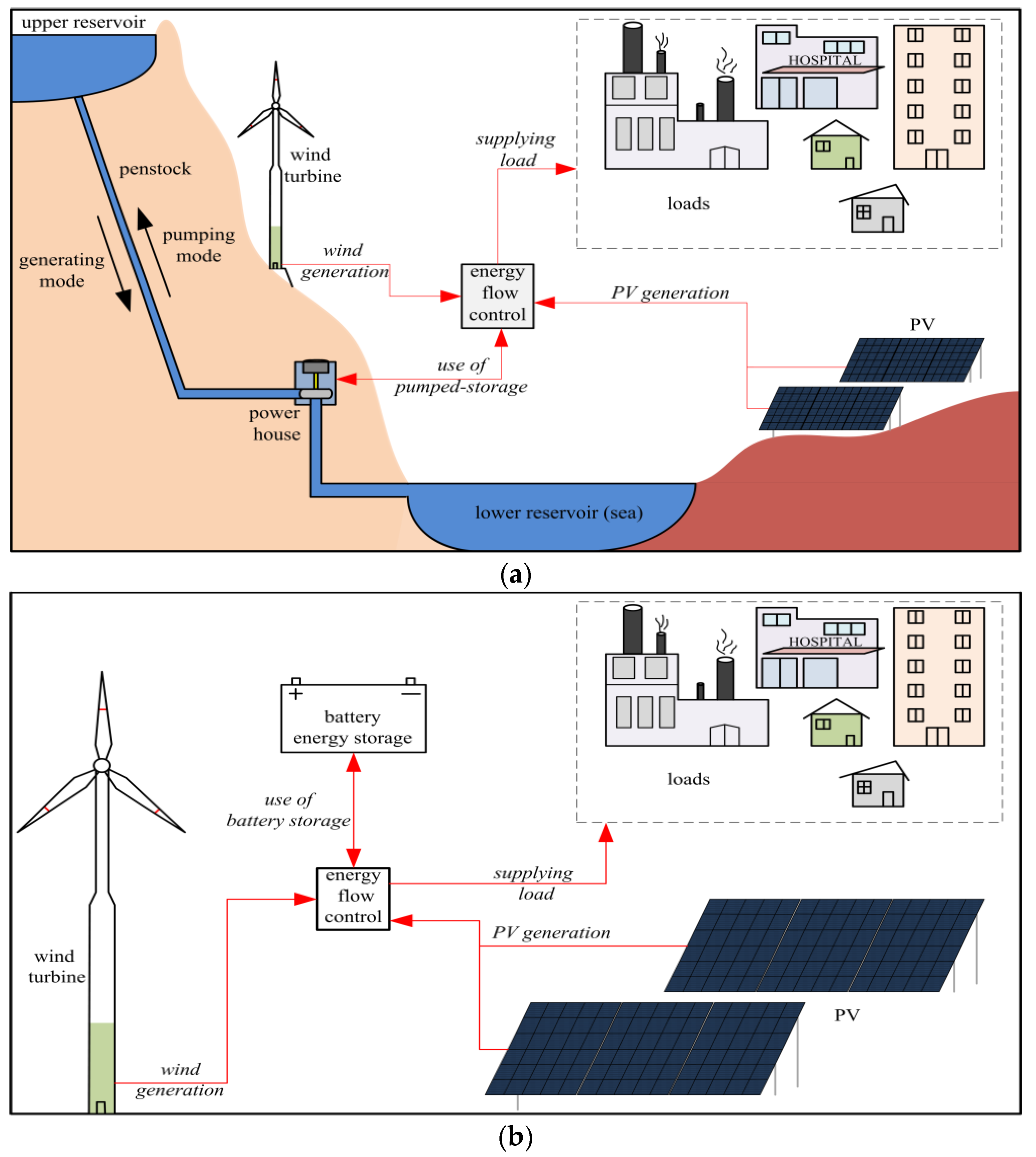
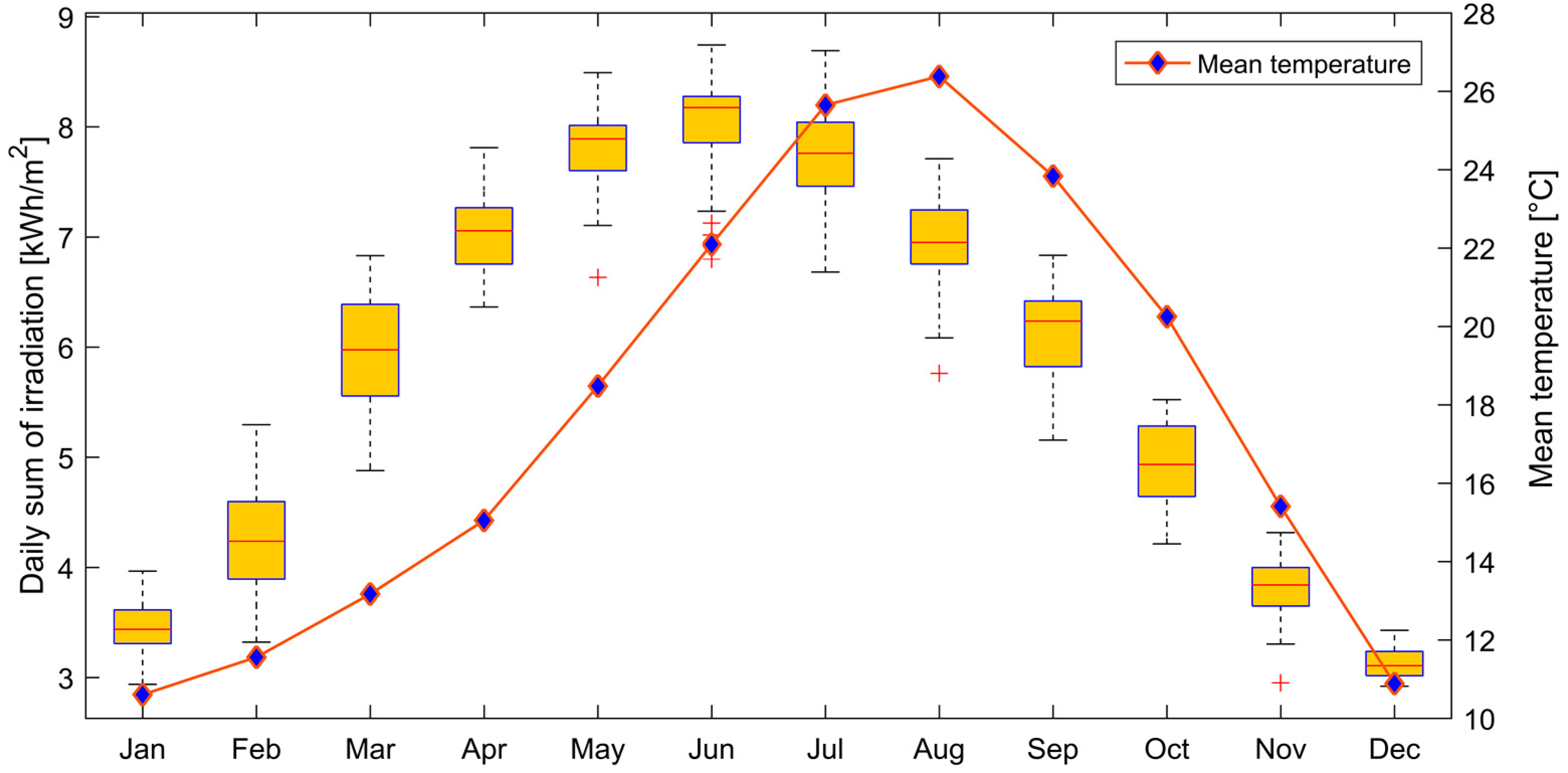

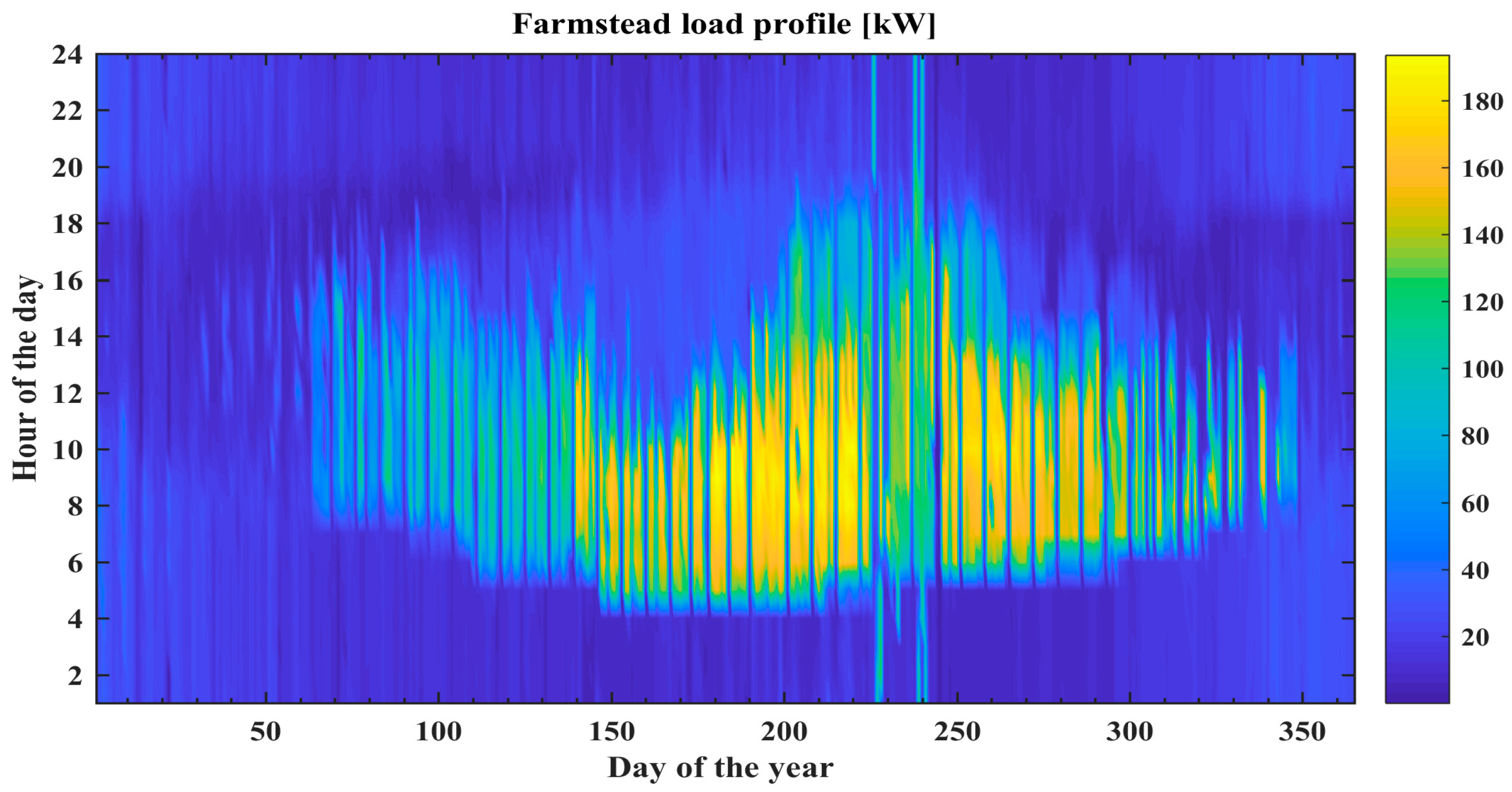
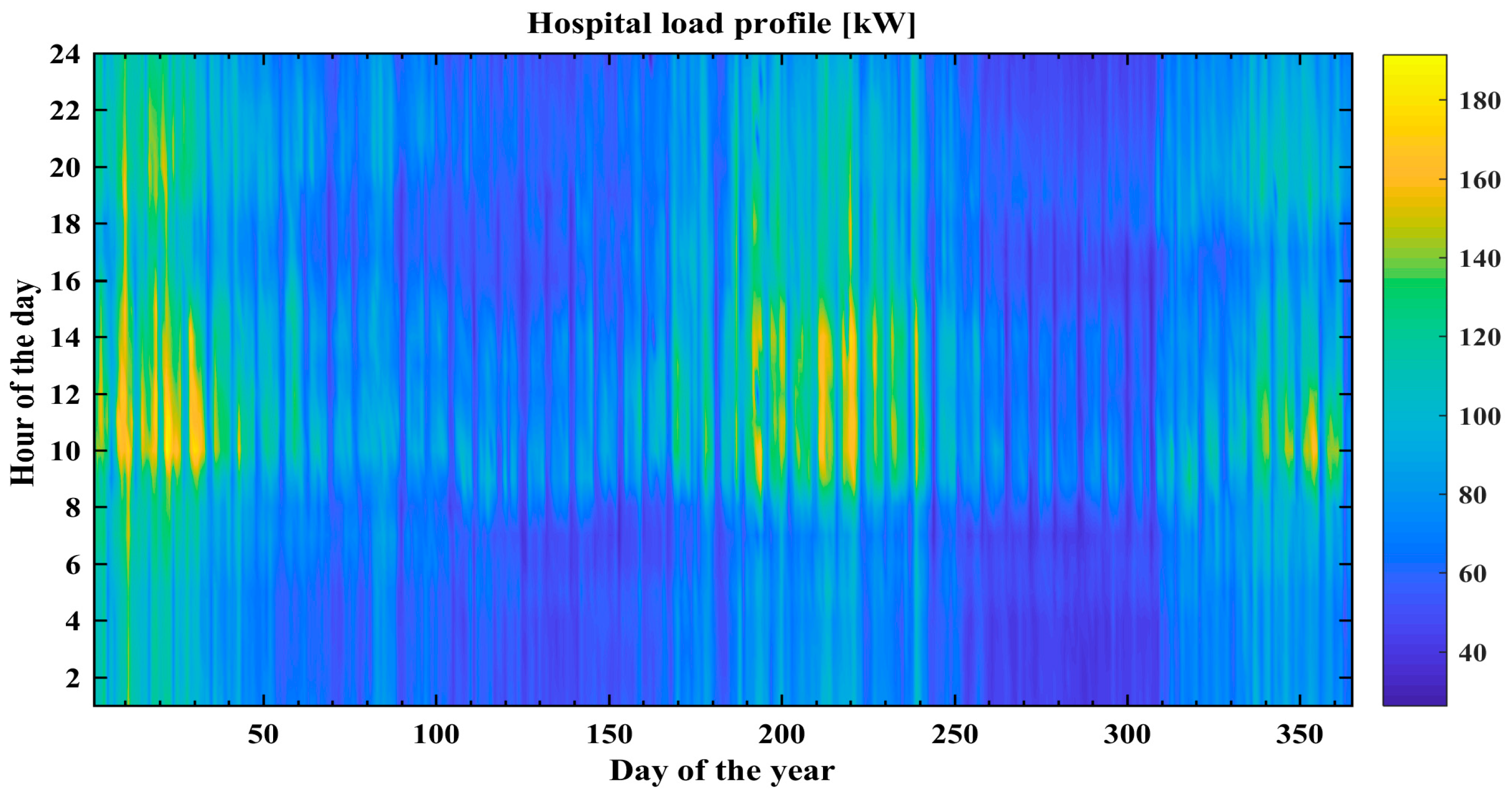

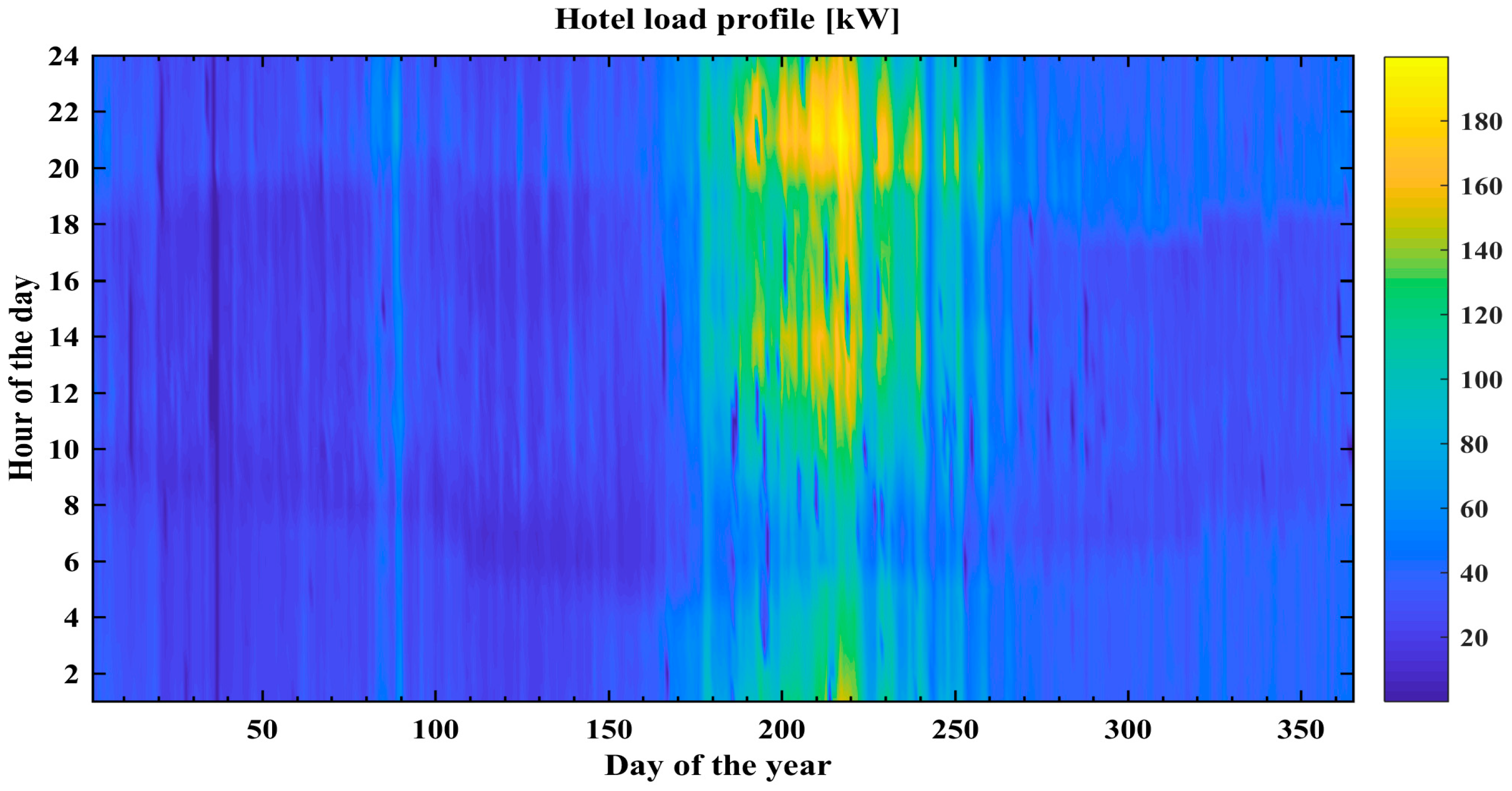


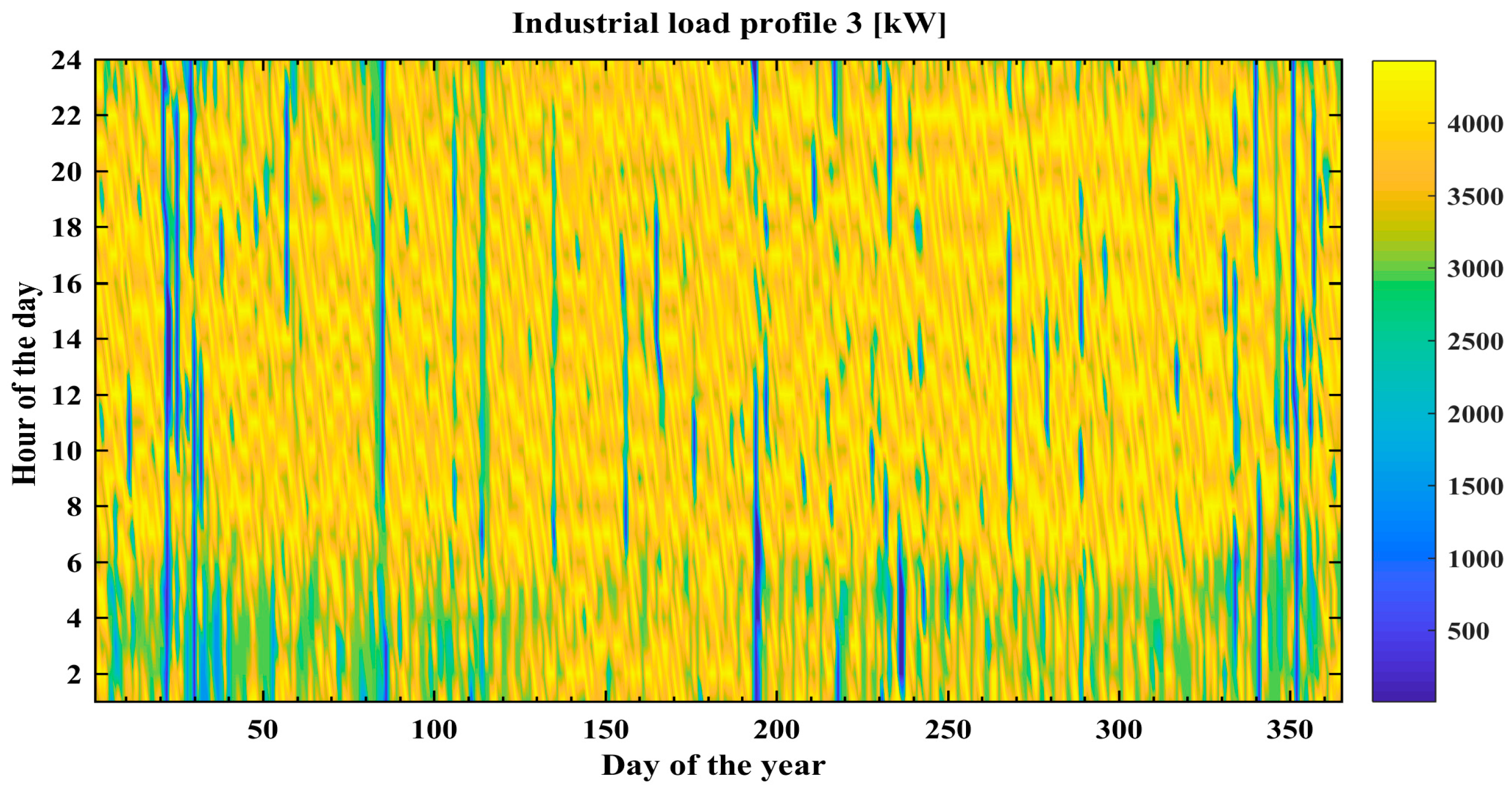
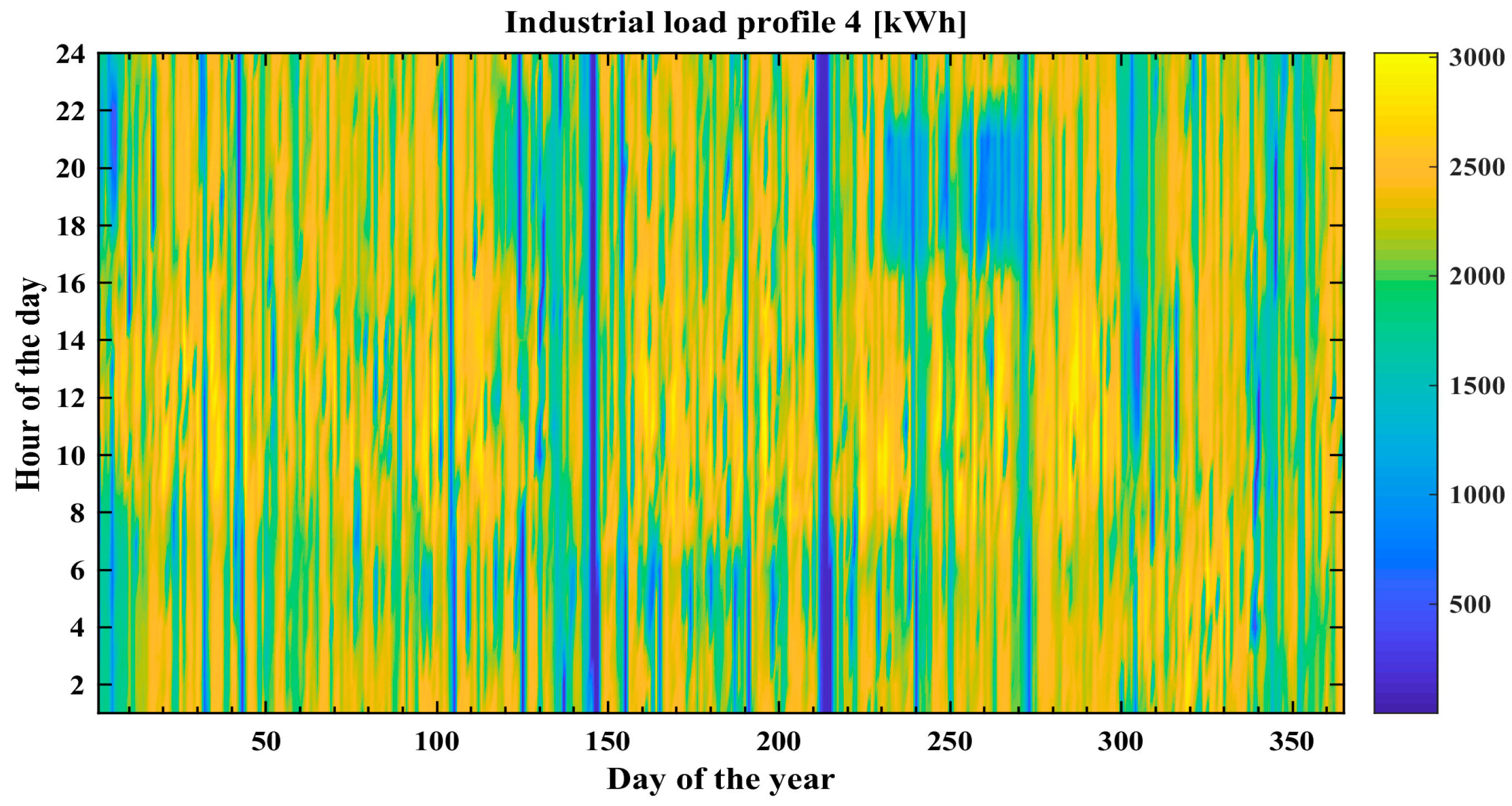
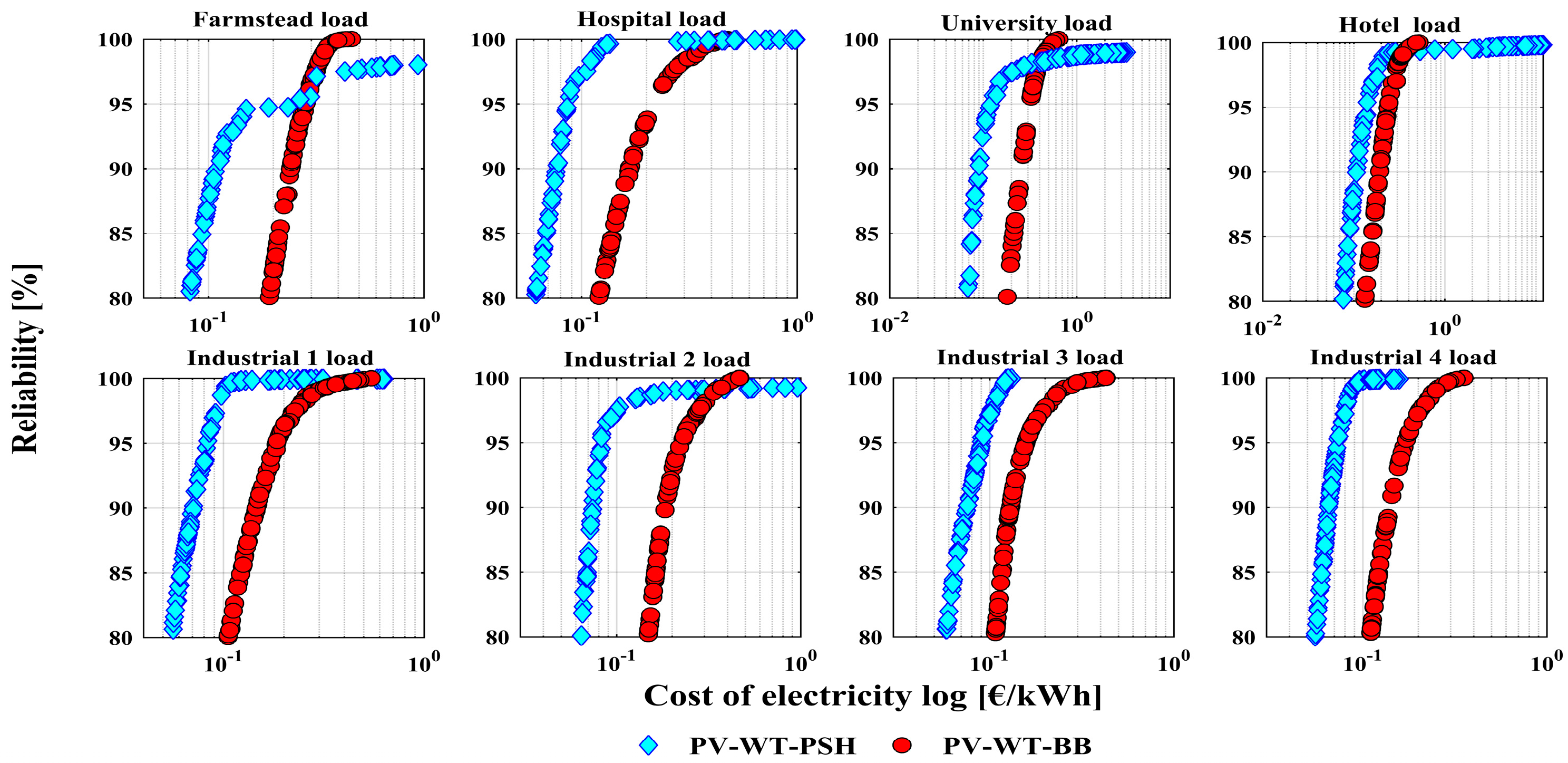

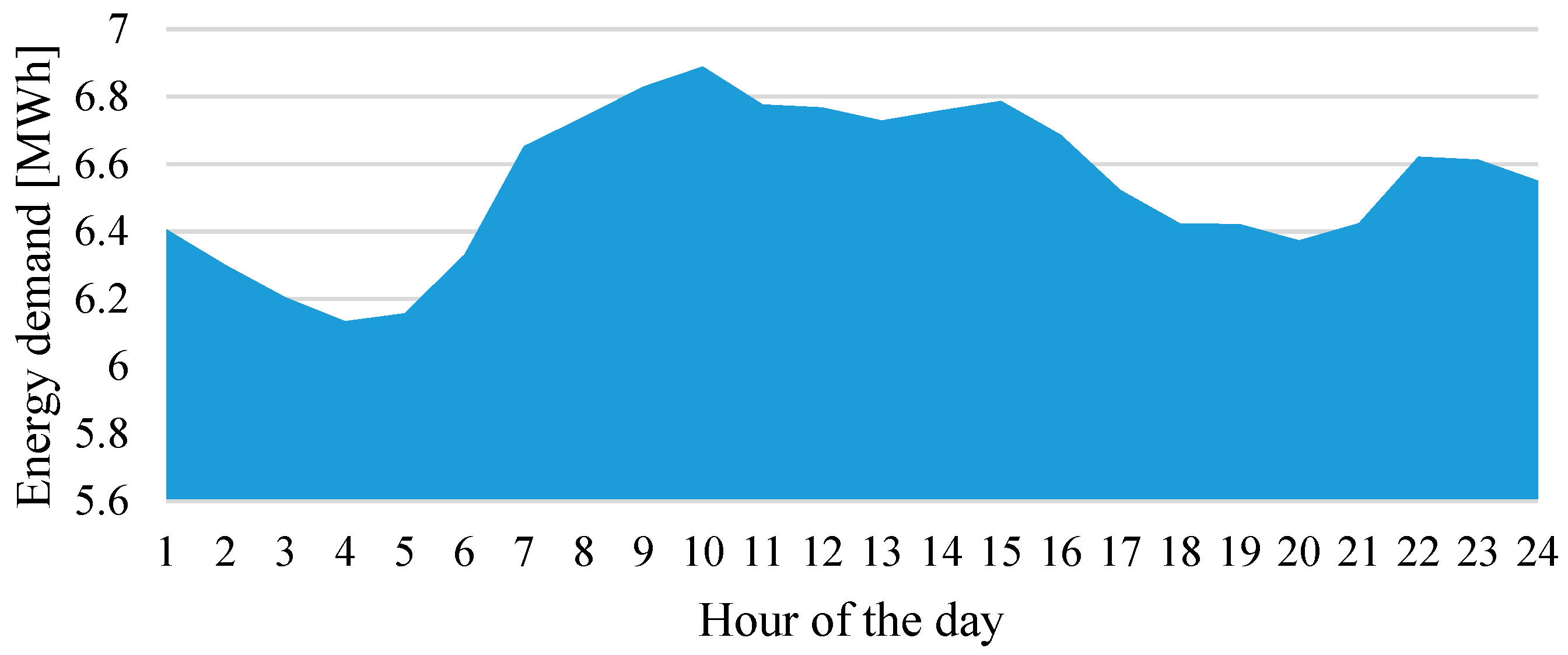
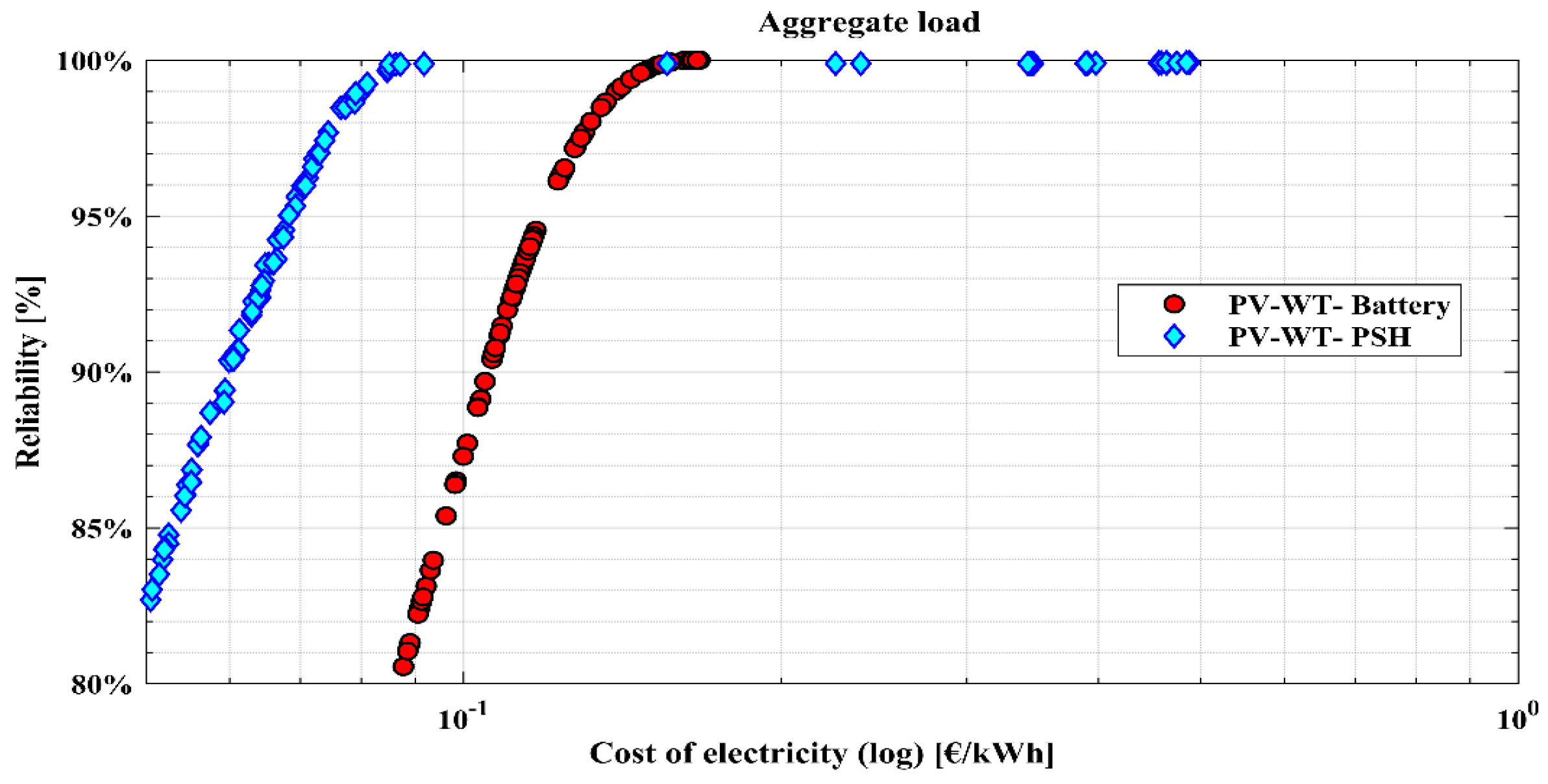
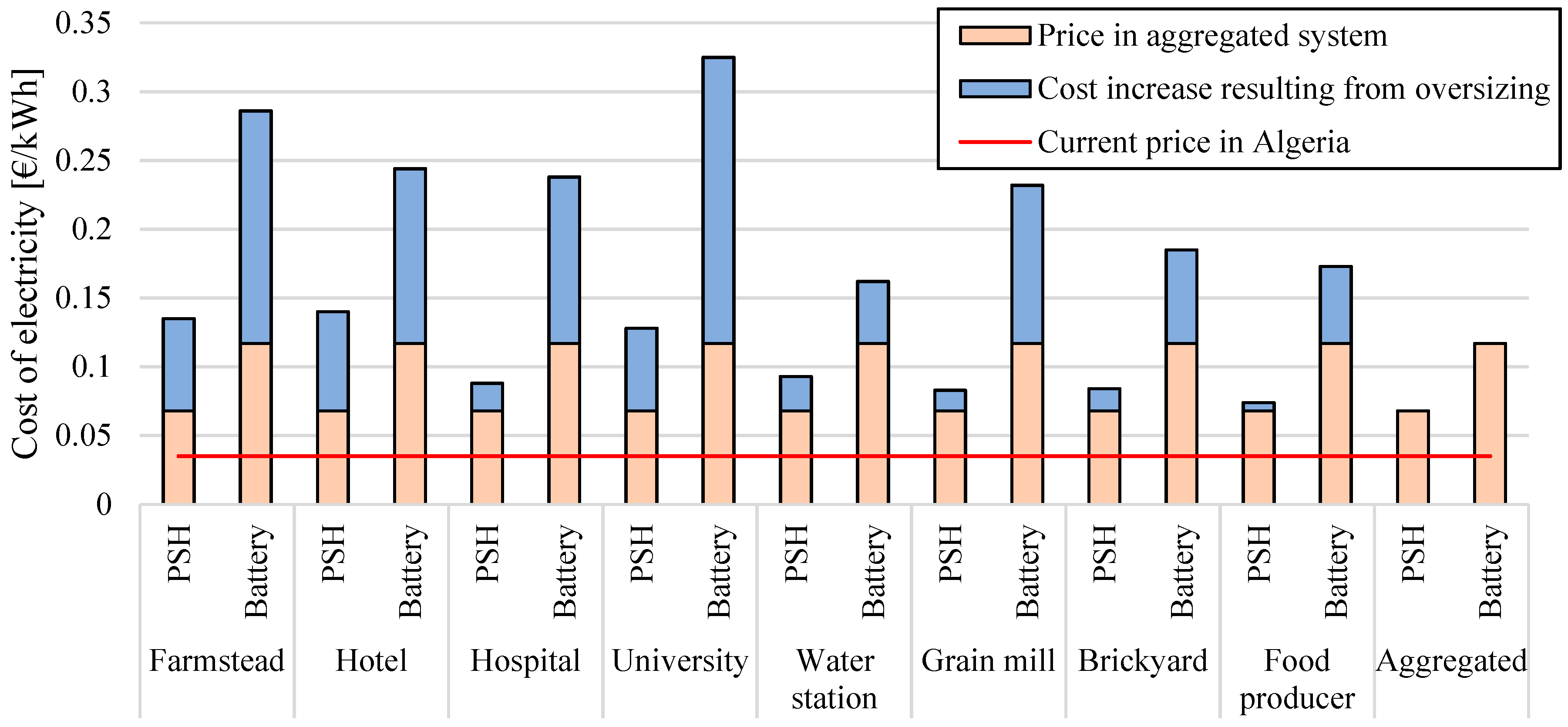
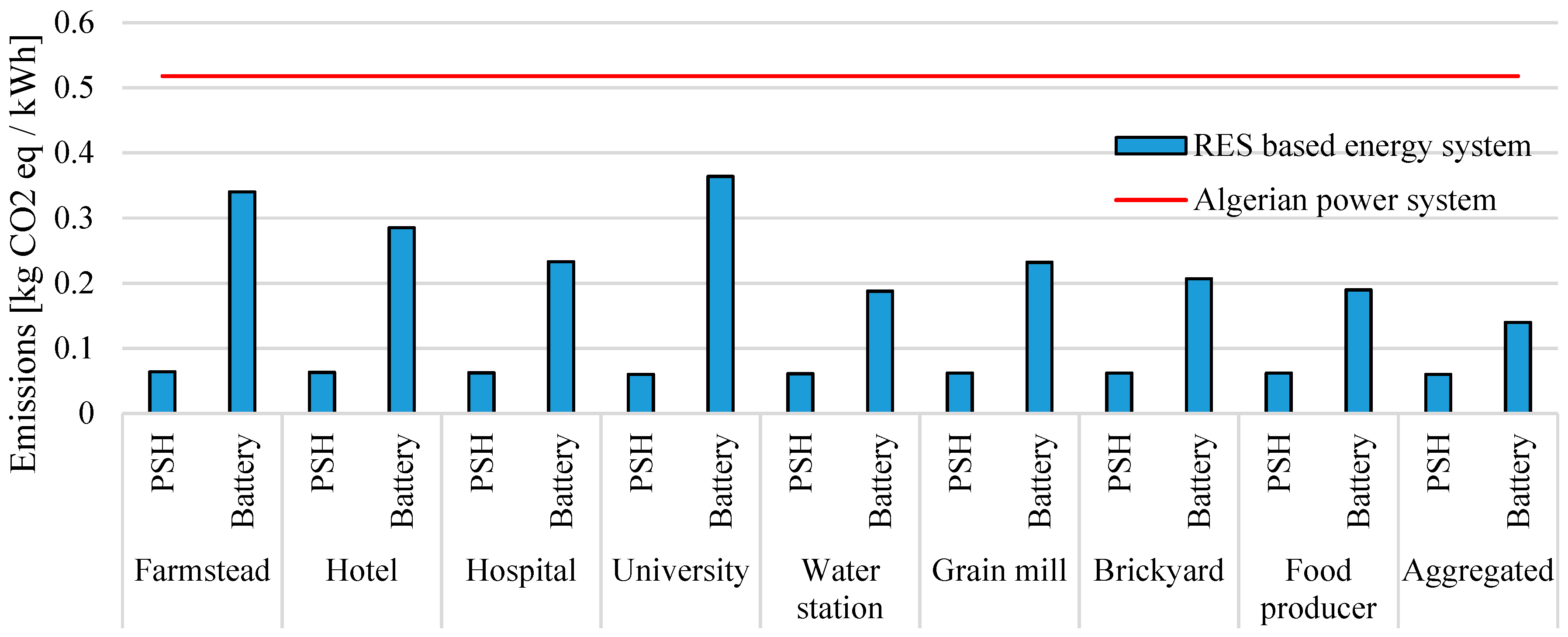
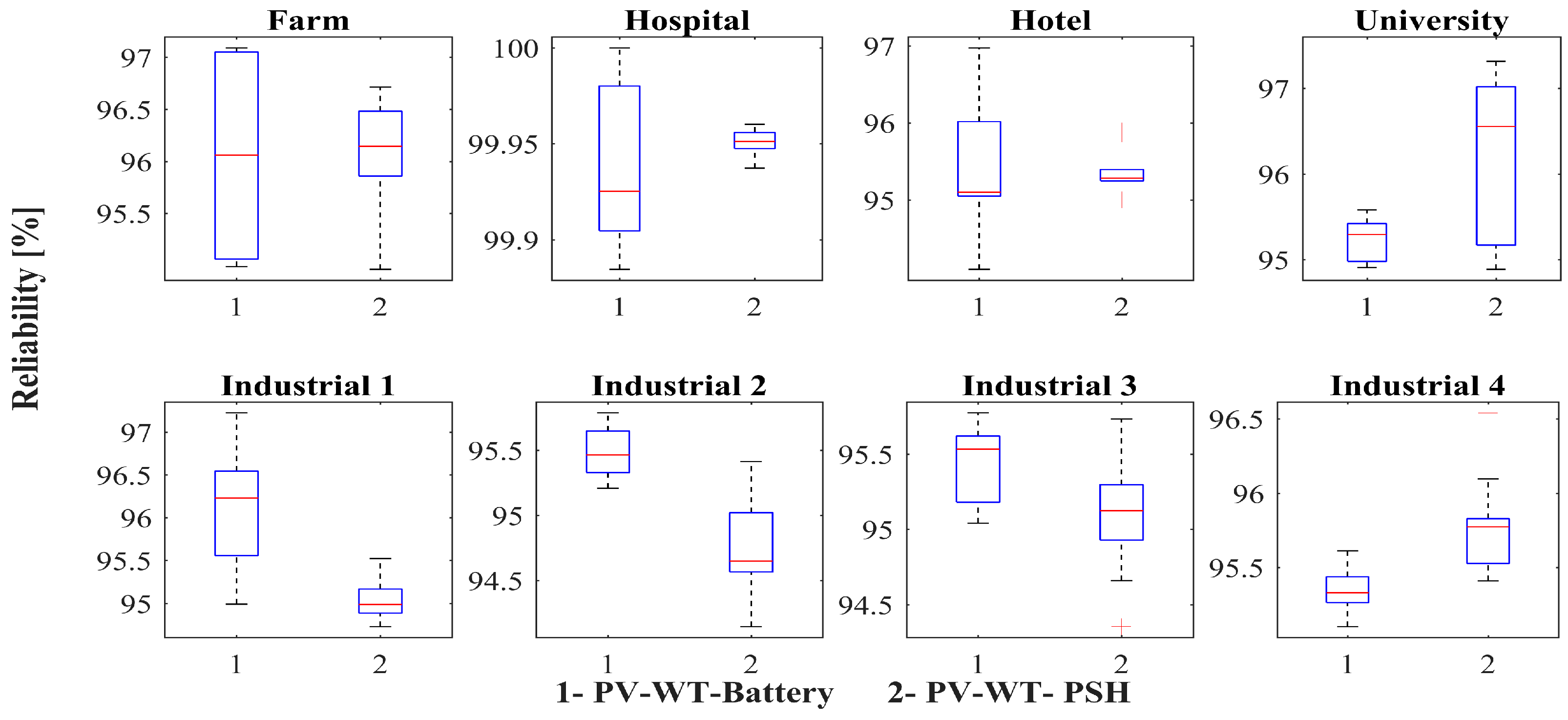
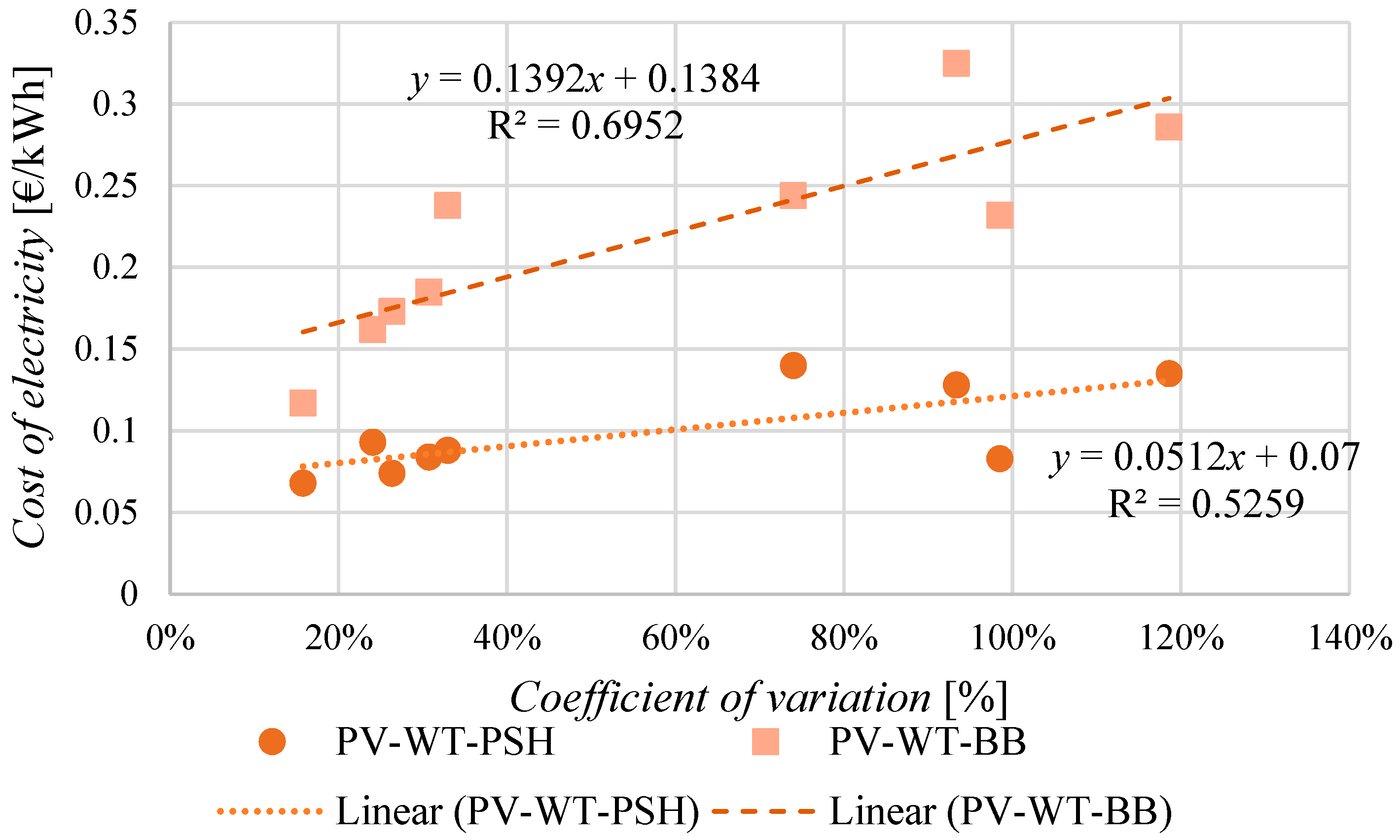
| Description | Data |
|---|---|
| Project lifespan [year] | 25 |
| Real discount rate [%] | 8 |
| PV system | - |
| Ccp [€/kW] | 700 |
| [%] | 2.5% of Ccp |
| CLFT | 25 |
| Wind turbine | - |
| Ccp [€/kW] | 1750 |
| [%] | 2.5% of Ccp |
| Prate [kW] | 225 |
| Hub height [m] | 100 |
| Vrate [m/s] | 14 |
| Vcut-in [m/s] | 3.5 |
| Vcut-out [m/s] | 25 |
| CLFT | 25 |
| Battery | - |
| Ccp [€/kWh] | 170 |
| [%] | 1.5% of Ccp |
| ηbat [%] | 85 |
| CLFT | 10 |
| PSH station | - |
| Ccp [€/kW] | 1051 |
| Reservoir [€/kWh] | 10 |
| [%] | 1.5% of Ccp |
| ηpsh [%] | 80 |
| CLFT | 60 |
| Parameters | Data |
|---|---|
| Number of iterations | 300 |
| Grey wolf population size | 100 |
| Archive Size | 100 |
| Repository Member Selection Pressure | 2 |
| Leader Selection Pressure Parameter | 4 |
| α Grid Inflation Parameter | 0.1 |
| Number of Grids per Dimension | 10 |
© 2019 by the authors. Licensee MDPI, Basel, Switzerland. This article is an open access article distributed under the terms and conditions of the Creative Commons Attribution (CC BY) license (http://creativecommons.org/licenses/by/4.0/).
Share and Cite
Guezgouz, M.; Jurasz, J.; Bekkouche, B. Techno-Economic and Environmental Analysis of a Hybrid PV-WT-PSH/BB Standalone System Supplying Various Loads. Energies 2019, 12, 514. https://doi.org/10.3390/en12030514
Guezgouz M, Jurasz J, Bekkouche B. Techno-Economic and Environmental Analysis of a Hybrid PV-WT-PSH/BB Standalone System Supplying Various Loads. Energies. 2019; 12(3):514. https://doi.org/10.3390/en12030514
Chicago/Turabian StyleGuezgouz, Mohammed, Jakub Jurasz, and Benaissa Bekkouche. 2019. "Techno-Economic and Environmental Analysis of a Hybrid PV-WT-PSH/BB Standalone System Supplying Various Loads" Energies 12, no. 3: 514. https://doi.org/10.3390/en12030514
APA StyleGuezgouz, M., Jurasz, J., & Bekkouche, B. (2019). Techno-Economic and Environmental Analysis of a Hybrid PV-WT-PSH/BB Standalone System Supplying Various Loads. Energies, 12(3), 514. https://doi.org/10.3390/en12030514






